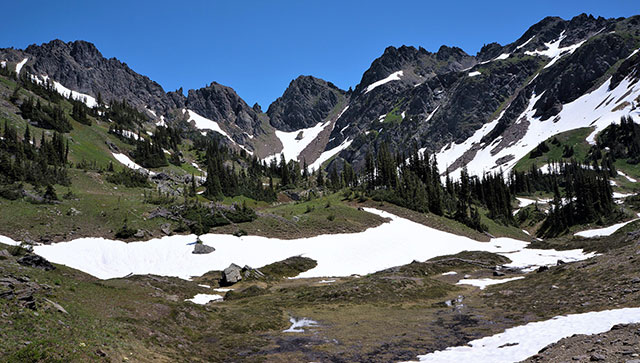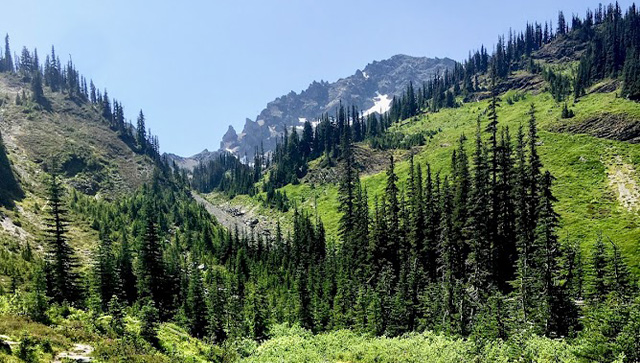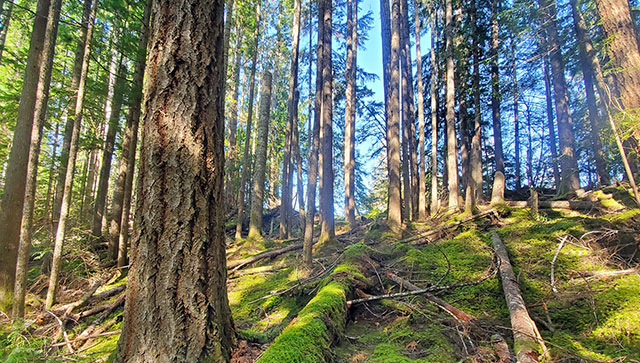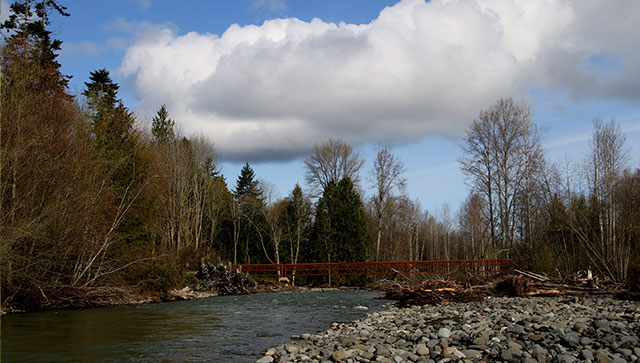Habitats

Alpine
This fragile, treeless area is made up of tundra grasses and plants that grow during the few snow-free weeks each year.
The high alpine meadows and ridges provide a summer home for wildflowers, butterflies and birds, including Horned Larks, American Pipits, and Gray-crowned Rosy Finches.
The Dungeness River begins its steep plunge to the sea at the snowfields and remnant glaciers on some of the highest peaks in the Olympic Mountains, including Mt. Deception (7,788 ft.), and Mt. Constance (7,756 ft.).

Subalpine
The principal trees of this zone, subalpine fir and Alaskan yellow-cedar have adapted to snowfall in different ways: the fir by having short, stiff branches that bear the weight of the snow, and the cedar by having extremely flexible branches that bend without breaking under heavy snow. The steep upper basins of the watershed, such as Royal Basin and the headwaters of the Graywolf River, contain stands of white bark pine, a tree typical of drier mountains in the western U.S.
Downslope from the high peaks and meadows is the Subalpine Zone, where snow stays on the ground for months at a time, typically from October to early summer.

Montane
Forest fires have played an important role in the rainshadow side of the Olympics, leading to the Douglas fir’s ability to quickly sprout on bare soil and to rapidly fill the forest canopy.
The tree in the Montane Zone, in contrast, is the western hemlock, able to germinate in undisturbed forest litter and to grow to adulthood in dense shade. These two species, along with western red-cedar, reach massive sizes in the wet river bottoms where fires haven’t burned and abundant ground water is always available. Where the old-growth forest has been left to reach maturity, weathered snags of fir and cedar provide nesting habitat for Spotted Owls, Marbled Murrelets, and Vaux’s Swifts.
Douglas-fir, a species that thrives in full sunlight, dominates the Montane, or middle elevation forests of the Olympic Mountains.

Riparian
The Riparian Habitat, or riverside forests, of the lower Dungeness River is constantly changing, as the river cuts new channels in the flood plain.
Trees and shrubs in the riparian zone have adapted to these uncertain conditions by quickly restoring themselves after fire and floods. Species such as black cottonwood, willows and red alder have rapid growth rates and produce huge numbers of seeds, all marks of pioneer species found in disturbed habitats. The massive cottonwoods in our park are probably less than 100 years old, yet are over 4 feet wide and stand 170 feet tall. Cottonwoods and willows can even sprout from small twigs that wash downstream and become buried in the silt and gravel. Other important trees of the riparian zone, like big-leaf maple, Douglas fir, and western red cedar, grow best in stable habitats on the edges of the flood plain.
The combination of deciduous and coniferous trees in the riparian forest, plus the mosaic of different ages and sizes that results when the forest recovers from past flooding, provides diverse habitats for many creatures.
In spring, the budding trees support large insect populations, which in turn support breeding songbirds. The songbirds feed in different ways: flying hunters like swallows and flycatchers grab gnats and moths out of the air; leaf gleaners like warblers and vireos pick caterpillars off of leaves, and trunk foragers like nuthatches and creepers pick the insects and spiders from the trunks of large trees. A bounty of berries and fruits on shrubs and trees produces food from summer through winter — blackberries, elderberries, Indian plum, salmonberries, thimbleberries, snowberries, serviceberries, currants, gooseberries, Oregon grape, salal, and oceanspray — providing nutrition for many species.

Estuary
At the river’s mouth, where freshwater mixes with tidal saltwater, lies the Estuary, a region of high productivity and a wide variety of diverse creatures.
The sheltered waters of Dungeness Bay provide feeding habitats for many predators, from tiny invertebrates to majestic eagles. The estuary also provides essential nursery grounds for fish, crustaceans, and many other organisms.
The water quality of Dungeness Bay has suffered from contaminants and sediments that wash downstream in the river, creeks, and irrigation ditches. Large sections of the Bay are now closed to shellfish harvest because of unhealthy levels of fecal coliform bacteria. The health of estuary habitats in Dungeness Bay are the responsibility of all residents of the watershed, by maintaining septic systems, using best management practices with livestock, controlling storm-water runoff, and always considering how our actions affect organisms downstream.

